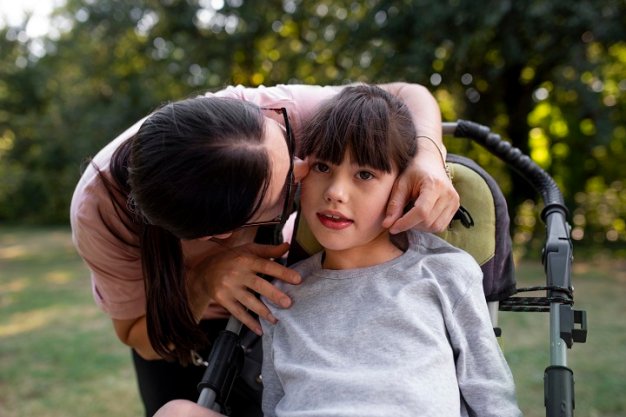Cerebral palsy, often misunderstood and underestimated, presents daily challenges. If you are a Cerebral Palsy patient or caregiver, you’re not alone. Join us as we explore the journey of living with cerebral palsy.
Keep reading to learn how those living with cerebral palsy can find empowerment in daily challenges.

Table of Contents
Understanding Cerebral Palsy
Cerebral palsy is a neurological disorder. It affects movement, muscle tone, and motor skills. Cerebral palsy is a group of permanent movement disorders.
It appears in early childhood. It is caused by abnormalities or damage to the developing brain. This affects muscle tone, motor skills, and coordination.
Its severity varies widely among individuals. The exact cause of cerebral palsy is unknown, but it is thought to result from a combination of factors. This includes prenatal, perinatal, or postnatal brain damage.
Risk factors include premature birth and low birth weight. Maternal infections during pregnancy, lack of oxygen during childbirth, and brain injury during infancy or early childhood are also risk factors.
Types of Cerebral Palsy
Cerebral palsy has different types. They are classified based on the type of movement disorder. They are also classified based on the parts of the body affected.
The main types include:
- Spastic CP – Characterized by muscle stiffness and difficulty moving limbs
- Dyskinetic CP – Involves involuntary, uncontrolled movements
- Ataxic CP – Affects balance and coordination, causing shaky movements
- Mixed CP – Combination of two or more types of CP
Overcoming Physical Challenges
Daily tasks that may seem simple to others can be more challenging for individuals with CP. Every activity requires adaptability and perseverance.
You need them to get dressed in the morning and navigate crowded spaces. Individuals with CP find ways to overcome these challenges. They use physical therapy.
They also use assistive devices. They are creative problem solvers. They find ways to live life to the fullest.
Independence
Individuals with CP achieve independence by taking care of themselves. This includes tasks like dressing, grooming, and feeding. It enhances their autonomy and self-esteem.
By learning adaptive strategies and using assistive devices, individuals can develop the skills needed to manage daily living activities independently. Developing communication skills and self-advocacy abilities empower individuals with CP.
They can then express their needs, preferences, and opinions effectively. Augmentative and alternative communication (AAC) devices, sign language, and communication boards can facilitate communication independence, enabling individuals to interact with others and advocate for themselves confidently.
Access to mobility aids like wheelchairs, walkers, and scooters is helpful for independence. Ramps, elevators, and accessible restrooms enable individuals to navigate public spaces.
They also help people feel more independent. Individuals with CP need independence in social activities.
They also need independence in community engagement. It fosters social connections. It fosters friendships and a sense of belonging.
Access to accessible transportation, recreational facilities, and community programs enables individuals to participate in social and leisure activities independently. Empowering individuals with CP to make informed decisions and exercise personal agency promotes independence and autonomy.
Providing opportunities for individuals to participate in decision-making processes related to their healthcare, living arrangements, and life goals enhances their sense of control and self-determination.
Build Support Networks
Living with CP can sometimes feel isolating. That’s why building strong support networks can provide invaluable encouragement and assistance. Support networks provide emotional support, understanding, and empathy.
This helps individuals cope with the emotional challenges of living with CP. Friends, family, peers, or support groups can offer a listening ear. They can also provide encouragement. It gives a sense of belonging.
Support networks provide access to valuable information and resources related to CP. This may include information about treatments, therapies, assistive devices, or educational programs. By sharing knowledge and connecting individuals with relevant resources, support networks empower individuals to make informed decisions about their care and treatment options.
Peer support networks connect individuals with CP to others who share similar experiences and challenges. This peer connection can be invaluable for reducing feelings of isolation. It can also help build a sense of community.
Support networks help people fit into society. They also help people take part in community life. You can do this by organizing social events.
You can also do this by planning recreational activities. Ultimately, support networks empower individuals with CP. They can take control of their lives.
They can pursue their goals with confidence. Finding a disability day centre can be life-changing for individuals living with CP.
Celebrate Achievements
Individuals with CP face challenges. Despite this, they achieve remarkable feats every day. Whether it’s reaching a personal milestone, overcoming a significant obstacle, or making a positive impact in their community.
These achievements deserve recognition and celebration. By celebrating their accomplishments, individuals with CP inspire others.
This also reinforces a sense of self-worth. It also reinforces empowerment. Pursuing passions is something to celebrate.
Celebrating is also for connecting with loved ones. Focusing on what brings joy and fulfillment can cultivate a sense of resilience and positivity. This can empower the ups and downs of living with cerebral palsy.
Celebrating achievements motivates people with CP to continue setting goals and strive for excellence. When individuals experience success and recognition for their efforts, they are inspired to continue pushing their limits, expanding their capabilities, and reaching new heights.
Advocating
Empowerment also comes from advocating for inclusion. It also comes from advocating for accessibility. It also comes from advocating for equal opportunities.
Advocacy efforts focus on promoting inclusion and accessibility in all aspects of life. This can include education, employment, healthcare, and community participation.
By advocating for accessible infrastructure, inclusive policies, and accommodations for individuals with CP, advocates help create environments where everyone can fully participate and contribute. Advocacy drives systemic change. It influences policies, practices, and attitudes.
These affect the lives of individuals with CP. Mobilizing grassroots movements can create a society that is more inclusive. Engaging with policymakers can also help.
Living With Cerebral Palsy Is Possible
Living with cerebral palsy is a journey. It is marked by resilience. It’s a journey of empowerment.
It’s a triumph over adversity. By embracing resilience and finding support, individuals living with disabilities empower themselves. They can live meaningful lives.
If you found our guide helpful, we have more where this came from. Keep browsing the rest of this section for our latest reads.




